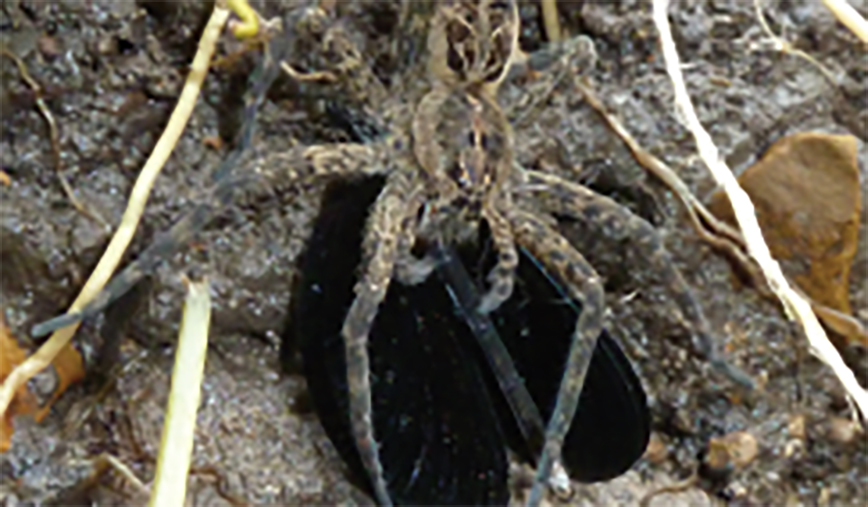June 25, 2015
Fishing Spider
A young female fishing spider snacks on an ebony jewelwing damselfly.
If you’ve ever traveled with teens or tweens (or me, for that matter) you know that food for the trip is a primary concern. Meals and snacks are planned just as carefully as the route and the restroom stops.
So it should come as no surprise to learn that last week, when I hit the road with the 6th-9th graders enrolled in Go 4 It (an awesome week-long program that includes four great outdoor activities, hiking, biking, canoeing and camping), we had enough food to last an entire weekend–even tho our trip was roughly 28 hours start to finish.
Our destination, Apple River Canyon State Park, was just far enough away to add a true sense of adventure. It was also just far enough that we made a spur-of-the-moment decision to stop for extra food in Belvidere. Because food was Just. That. Important.
Apples. Oranges. Bananas. Carrots sticks (and dip). Potato chips. Pretzels. Hot dogs, buns and condiments. Hershey bars, marshmallows and graham crackers–that’s right, for s’mores. Bagels and cream cheese. Peanut Butter. Cinnamon roll dough (baked inside hollowed-out oranges, over an open fire).
Oh, and for one individual, a heaping helping of Calopteryx maculata.
Now’s probably as good of a time as any to mention that that particular individual came somewhat late to the party. We ran into her after we arrived at the state park. She was down by Clear Creek, a wonderful tributary of the Apple River, where throngs of C. maculata, or ebony jewelwing damselflies, were fluttering about.
She was quiet. And quite hungry. And her name is Dolomedes – the fishing spider.
Fishing spiders are the sorts of arachnids that, even if you’re okay with spiders and such, can give you pause. The body length of females (the larger of the two genders) can reach 26 mm, which is more than 1 in. Add on legs that are over 40 mm, or 1 ½ in., and you have a spider whose visual presence approaches 3 in.—a lot of spider for any region, but particularly for us here in northern Illinois, where most arachnids are but a fraction of that size.
I’ve run into fishing spiders on and off over the years, most frequently when I worked at Red Oak Nature Center in North Aurora. Down by Devil’s Cave, the little geologic curiosity along the Fox River, south of the nature center, I’d often come across fishing spiders basking on the rocks in the afternoon sun.
Only once during that time did I see a fishing spider actually appear to be fishing. She was at the edge of the river, back legs on land and front legs extending out onto the water, waiting to sense the vibrations of approaching prey—animals that range from insects to small fish.
Bedecked with short, velvety hairs that repel water, fishing spiders are able to
move about on the surface of a pond or stream, or submerse themselves and breathe the air trapped between the hairs in a sort of all-encompassing scuba suit.
Our Ms. Dolomedes from last week may or may not have taken advantage of these special features to help catch her damselfly snack. What I do know is that she was intent on consuming it, and neither the commotion of a dozen nature campers splashing through the creek, nor the intrusion of a camera—with a flash, even—would deter her from finishing her meal.
Like the camp kids, this spider was a teen too. A sub-adult, that is, maybe three-quarters of her adult size. Another molt or two and she would be fully mature and ready to take on her next mission—courtship aimed at finding a mate. (If I had more time, or space, I would love to share some of the human courtship strategies I overheard being discussed by our own sub-adult campers: Choices in body wash fragrances. Hair styles. Cheesy pickup lines. My favorite? “If you were a booger, I’d pick you first.” Ah, middle school…)
As the teens and tweens made their way farther upstream, under the watchful eyes of their instructors Miss Kate and Miss Jenna, I stayed behind to watch the fishing spider finish her meal. She deftly manipulated the damselfly–which she’d captured by ambush and stunned with venom—using her pedipalps, the sensory appendages sometimes mistaken for legs at the front of every spider’s body.
Munch, turn. Munch, turn. The spider was meticulous and almost dainty the way she maneuvered her meal.
I watched her for a good 20 minutes before hearing the sounds of the Go 4 It kids heading back downstream. When we met up again, I made sure they kept quiet, so as to not to disturb Dolomedes during her last few bites. We tiptoed our way past the spider, down the creek and then up the bluff to our campsite.
The campers had lots to share about their adventures. They had seen fish and crayfish, found deer and raccoon tracks, fell down, splashed and in general had a rollicking great time. I told them about the spider and what I’d observed. Before we knew it, we were back at camp–with just enough time to grab a snack before dinner.
Pam Erickson Otto is the manager of nature programs and interpretive services at the Hickory Knolls Discovery Center, a facility of the St. Charles Park District. She can be reached at 630-513-4346 or potto@stcparks.org.

